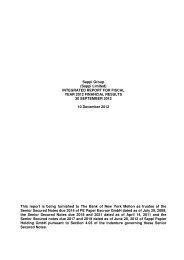2007 Annual Report - Sappi
2007 Annual Report - Sappi
2007 Annual Report - Sappi
You also want an ePaper? Increase the reach of your titles
YUMPU automatically turns print PDFs into web optimized ePapers that Google loves.
Notes to the group annual financial statements continued<br />
for the year ended September <strong>2007</strong><br />
2. Accounting policies continued<br />
management. In addition, management focuses close attention<br />
to good husbandry techniques and fire-fighting methods.<br />
The plantations have an integrated management system that<br />
is certified to ISO 9001, ISO 14001, OHSAS 18001 and<br />
FSC standards.<br />
For further information see note 11 of our group annual<br />
financial statements.<br />
Post-employment benefits<br />
The group accounts for its pension benefits and its other post<br />
retirement benefits using actuarial models. These models use<br />
an attribution approach that generally spreads individual events<br />
over the service lives of the employees in the plan. Examples of<br />
“events” are changes in actuarial assumptions such as discount<br />
rate, expected long-term rate of return on plan assets, and<br />
rate of compensation increases. The principle underlying the<br />
required attribution approach is that employees render service<br />
over their service lives on a relatively consistent basis and,<br />
therefore, the income statement effects of pension benefits or<br />
post retirement healthcare benefits are earned in, and should be<br />
expensed in the same pattern.<br />
Numerous estimates and assumptions are required, in the<br />
actuarial models, to determine the proper amount of pension<br />
and other post retirement liabilities to record in the group’s<br />
consolidated financial statements and set the expense for the<br />
next fiscal year. These include discount rate, return on assets,<br />
salary increases, health care cost trends, longevity and service<br />
lives of employees. Although there is authoritative guidance on<br />
how to select these assumptions, our management and its<br />
actuaries exercise some degree of judgement when selecting<br />
these assumptions. Selecting different assumptions, as well as<br />
actual versus expected results, would change the net periodic<br />
benefit cost and funded status of the benefit plans recognised<br />
in the financial statements.<br />
Refer to notes 28 and 29 for the key assumptions, the benefit<br />
obligations and plan assets and net periodic pension cost as at<br />
the end of September <strong>2007</strong> and September 2006.<br />
The impact on the future financial results of the group in<br />
relation to post-employment benefits is dependent on<br />
economic conditions, employee demographics and investment<br />
performance. A 1% increase in discount rates would<br />
decrease the related pension expense liability by approximately<br />
US$175 million and the related pension expense by approximately<br />
US$6 million per annum. A 1% increase in the health care cost<br />
trend rates would increase the accumulated other postemployment<br />
benefit obligation by US$14 million and the<br />
aggregate of the service and interest cost components of net<br />
periodic other post-employment benefit cost by US$1 million<br />
after tax per annum.<br />
Provisions<br />
Provisions are required to be recorded when the group has a<br />
present legal or constructive obligation as a result of past<br />
events, for which it is probable that an outflow of economic<br />
benefits will occur, and where a reliable estimate can be made<br />
of the amount of the obligation. Best estimates, being the<br />
amount that the group would rationally pay to settle the<br />
obligation, are recognised as provisions at balance sheet date.<br />
Risks, uncertainties and future events, such as changes in law<br />
and technology, are taken into account by management in<br />
determining the best estimates.<br />
Where the effect of discounting is material, provisions are<br />
discounted. The discount rate used is the pre-tax rate that<br />
reflects current market assessments of the time value of money<br />
and, where appropriate, the risks specific to the liability, all of<br />
which requires management judgement.<br />
The establishment and review of the provisions requires<br />
significant judgement by management as to whether or not there<br />
is a probable obligation and as to whether or not a reliable<br />
estimate can be made of the amount of the obligation, which<br />
requires judgements as to the likelihood of future payment. All<br />
provisions are reviewed at each balance sheet date. Various<br />
uncertainties can result in obligations not being considered<br />
probable or estimable for significant periods of time. As a<br />
consequence, potentially material obligations may have no<br />
provisions and a change in facts or circumstances that results in<br />
an obligation becoming probable or estimable can lead to a need<br />
for the establishment of material provisions. In addition, where<br />
estimated amounts vary from initial estimates the provisions may<br />
be revised materially, up or down, based on the facts.<br />
The group periodically restructures its business units for<br />
productivity and business improvement initiatives and records<br />
charges for reductions in its workforce, the closure of<br />
manufacturing facilities, and other actions related thereto. These<br />
events require estimates of liabilities for employee separation<br />
payments and related benefits, equipment removal,<br />
environmental cleanup and other costs. The actual costs<br />
incurred could differ materially from those estimated at balance<br />
sheet date.<br />
90<br />
sappi limited | 07 | annual report
















